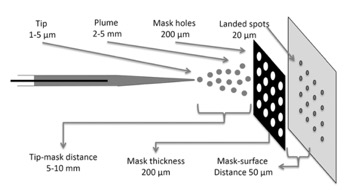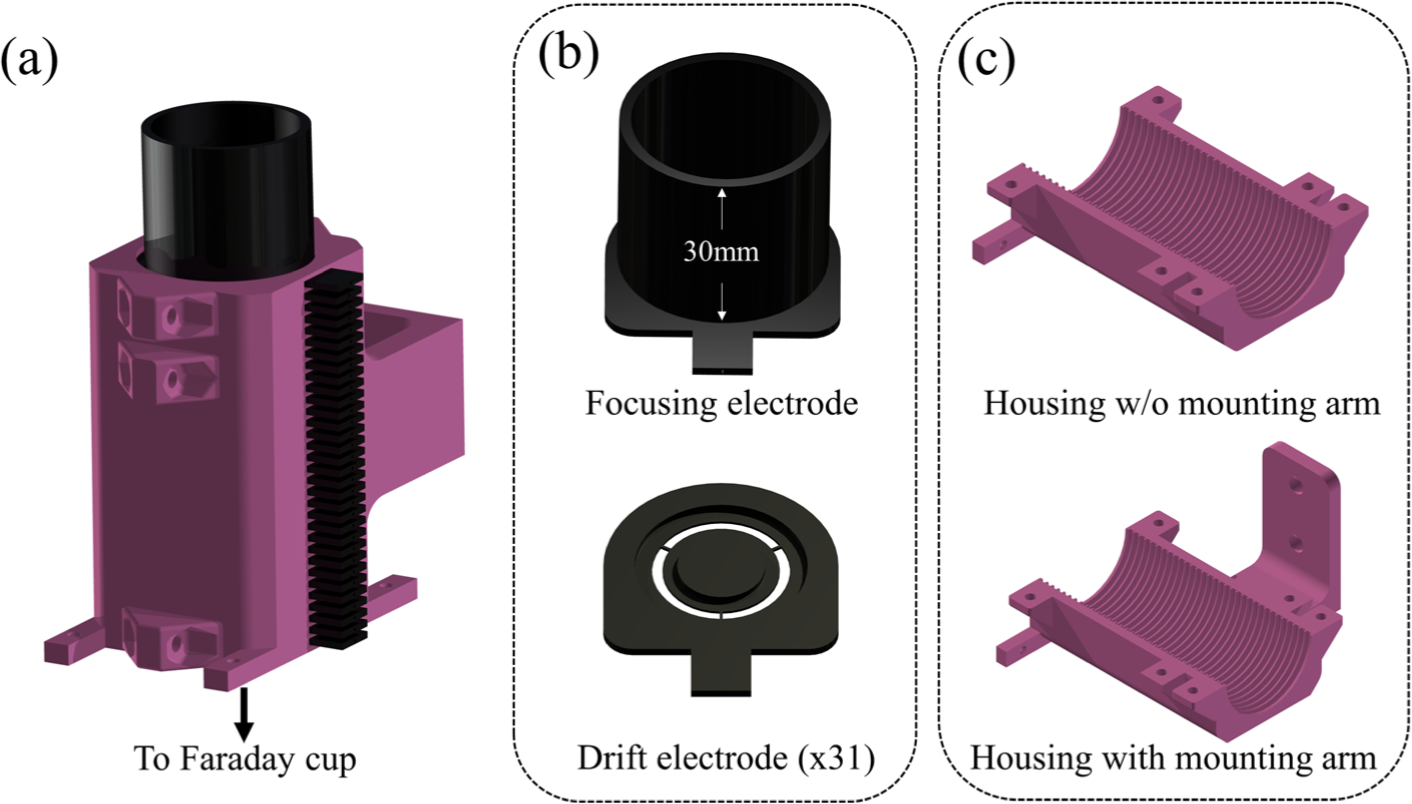Ambient Pressure Ion Manipulation and Ion Mobility Spectrometry
While ions have traditionally undergone handling in the vacuum environment of a mass spectrometer, the ability to generate ions in the open air by ESI and ambient ionization techniques such as DART and DESI have led to interest in controlling ions under ambient conditions. To this end, we have pursued several projects dedicated to understanding how ions behave at high pressures.
Early work in ambient pressure ion manipulation resulted in the development of ambient soft landing, an atmospheric pressure analog to traditional soft landing experiments. In these experiments, molecular ions were reacted with surfaces and molecules deposited onto surfaces. Further experiments demonstrated atmospheric pressure focusing of ions passed through small orifices by a factor of 10. Later work has exploited this effect for the patterning of surfaces using nanomaterials with different “masks” for deposition.

Figure 1. Schematic view of masked ion deposition experiment with atmospheric pressure ion focusing.
Further experiments in ambient pressure ion manipulation have demonstrated ion focusing using an ellipsoidal electrode operating at high pressure. Here, a beam of nanosprayed ions was focused and profiled using an ionCCD detector. It was found that ion beams of only a few mm in width with high flux could be produced using this technique. Coupling the focusing electrode to a mass spectrometer resulted in increased transfer efficiency of nanosprayed ions to the mass spectrometer.

Figure 2. View of (a) plastic ion focusing device, (b) ion trajectories in device, and (c) electric fields within device.
Finally, the use of 3D printing has allowed for the creation of numerous atmospheric pressure ion manipulation devices. In this work, electrodes designed using a CAD software package are 3D printed using a carbon nanotube doped plastic filament. The carbon nanotubes give modest conductivity to the plastic, allowing for application of high voltage. A 3D printed device which allows for ion separation, ion-molecule reactions, and ion focusing has been developed and demonstrated. More recent work has focused on the development of ion mobility spectrometers using only ambient air as the separation gas.
Figure 3. Renderings of (a) 3D printed IMS, (b) focusing and drift electrodes, and (c) individual housing pieces.
The current directions of this work are twofold: first, experiments are underway to elucidate the mechanisms of atmospheric pressure ion focusing the reactions of focused ions with gaseous species and surfaces. These experiments will improve fundamental understanding of ion reactivity and behavior. Secondly, we aim to improve the ion mobility instruments we have developed. Here, the focus is on understanding how environmental conditions influence ion mobility spectra and achieving chiral selectivity in ambient ion mobility.
Publications
- Badu-Tawiah, A. K.; Wu, C.; Cooks, R. G., Ambient Ion Soft Landing. Anal. Chem. 2011, 83 (7), 2648-2654.
- Franchetti, V.; Solka, B. H.; Baitinger, W. E.; Amy, J. W.; Cooks, R. G., Soft landing of ions as a means of surface modification. Int. J. Mass Spectrom. Ion Phys. 1977, 23 (1), 29-35.
- Badu-Tawiah, A. K.; Cyriac, J.; Cooks, R. G., Reactions of Organic Ions at Ambient Surfaces in a Solvent-Free Environment. J. Am. Soc. Mass. Spectrom. 2012, 23 (5), 842-849.
- Li, A.; Baird, Z.; Bag, S.; Sarkar, D.; Prabhath, A.; Pradeep, T.; Cooks, R. G., Using Ambient Ion Beams to Write Nanostructured Patterns for Surface Enhanced Raman Spectroscopy. Angew. Chem. 2014, 126 (46), 12736-12739.
- Baird, Z.; Peng, W.-P.; Cooks, R. G., Ion transport and focal properties of an ellipsoidal electrode operated at atmospheric pressure. Int. J. Mass Spectrom. 2012, 330-332, 277-284.
- Baird, Z.; Wei, P.; Cooks, R. G., Ion creation, ion focusing, ion/molecule reactions, ion separation, and ion detection in the open air in a small plastic device. Analyst 2015, 140 (3), 696-700.
- Hollerbach, A.; Baird, Z.; Cooks, R. G., Ion Separation in Air Using a Three-Dimensional Printed Ion Mobility Spectrometer. Anal. Chem. 2017, 89 (9), 5058-5065.
- Hollerbach, A.; Fedick, P. W.; Cooks, R. G., Ion Mobility–Mass Spectrometry Using a Dual-Gated 3D Printed Ion Mobility Spectrometer. Anal. Chem. 2018, 90 (22), 13265-13272.
